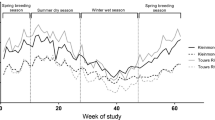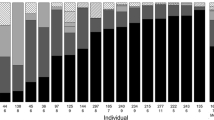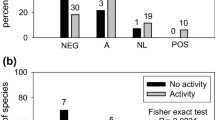Abstract
Electrophoretic surveys of two lizard species were used to test hypotheses that relate levels of enzyme variability to enzyme function (single-substrate versus multiple-substrate enzymes, regulatory versus nonregulatory enzymes). Anolis roquet behaviorally regulates its body temperature, but its congener A. gundlachi is passive to variations in the thermal environment. As a result, populations of A. gundlachi probably experience the thermal environment as temporally coarse-grained, whereas populations of A. roquet do not. We therefore predicted that A. gundlachi would exhibit greater enzyme heterozygosity than A. roquet and that different enzyme classes would contribute disproportionately to this interspecific difference. The data show (1) that A. gundlachi does have a higher heterozygosity and (2) that this difference appears to result from high levels of heterozygosity at loci coding for multiple-substrate enzymes. The dichotomy between regulatory and nonregulatory enzymes offers no explanation for the variability in heterozygosity among enzyme loci in these species.
Similar content being viewed by others
References
Ayala, F. J. (1975). Genetic differentiation during the speciation process. Evolution. Biol. 81.
Coyne, J. A. (1982). Gel electrophoresis and cryptic protein variation. In Rattazzi, M. C., Scandalios, J. G., Whitt, G. S., (eds.), Isozymes: Current Topics in Biological and Medical Research, Vol. 6 Alan R. Liss, New York, pp. 1–32.
Gillespie, J. H., and Kojima, K. (1968). The degree of polymorphism in enzymes involved in energy production compared to that in nonspecific enzymes in two Drosophila ananassae populations. Proc. Natl. Acad. Sci. USA 61582.
Gillespie, J. H., and Langley, C. H. (1974). A general model to account for enzyme variation in natural populations. Genetics 76837.
Hertz, P. E. (1981). Adaptation to altitude in two West Indian anoles (Reptilia: Iguanidae): Field thermal biology and physiological ecology. J. Zool. Lond. 19525.
Hertz, P. E., and Zouros, E. (1982). Genetic variability in two West Indian anoles: Relation to field thermal biology. J. Zool. Lond. 196499.
Hochachka, P. W., and Somero, G. N. (1973). Strategies of Biochemical Adaptation Saunders, Philadelphia.
Johnson, G. B. (1974). Enzyme polymorphism and metabolism. Science 18428.
Kimura, M., and Ohta, T. (1974). On some principles governing molecular evolution. Proc. Natl. Acad. Sci. USA 712848.
King, J. L., and Ohta, T. (1975). Polyallelic mutational equilibria. Genetics 79681.
Levins, R. (1968). Evolution in Changing Environments Princeton University Press, Princeton, N.J.
Lewontin, R. (1974). The Genetic Basis of Evolutionary Change Columbia University Press, New York.
Nei, M., and Roychoudhury, A. K. (1974). Sampling variances of heterozygosity and genetic distance. Genetics 76379.
Nevo, E. (1978). Genetic variation in natural populations: Patterns and theory. Theor. Pop. Biol. 13121.
Selander, R. K., and Kaufman, D. W. (1973). Genic variability and strategies of adaptation in animals. Proc. Natl. Acad. Sci. USA 701875.
Singh, R. S. (1979). Genic heterogeneity within electrophoretic “alleles” and the pattern of variation among loci in Drosophila pseudoobscura. Genetics 93997.
Zouros, E. (1979). Mutation rates, population sizes, and amounts of electrophoretic variation of enzyme loci in natural populations. Genetics 92623.
Author information
Authors and Affiliations
Additional information
E.Z. was supported by a grant from the Natural Sciences and Engineering Council of Canada. The study was accomplished while P.E.H. held a postdoctoral fellowship from the Killam Trust of Dalhousie University and a grant from the Research Development Fund of Dalhousie University. The collection of material was made possible by grants (to P.E.H.) from National Science Foundation (DEB 75-16334), the Explorers Club of New York, Sigma Xi, and the Richmond and Anderson Funds of Harvard University. We thank Dr. D. W. Foltz for his help with the calculations.
Rights and permissions
About this article
Cite this article
Zouros, E., Hertz, P.E. Enzyme function and polymorphism: A test in two Anolis lizard species. Biochem Genet 22, 89–97 (1984). https://doi.org/10.1007/BF00499289
Received:
Revised:
Issue Date:
DOI: https://doi.org/10.1007/BF00499289




